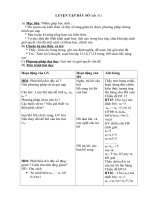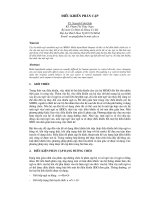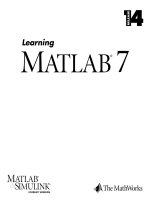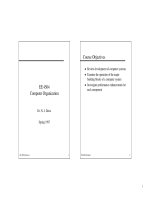Tài liệu EE 4504 Computer Organization pptx
Bạn đang xem bản rút gọn của tài liệu. Xem và tải ngay bản đầy đủ của tài liệu tại đây (220.19 KB, 29 trang )
1
EE 4504 Section 1 1
EE 4504
Computer Organization
Dr. N. J. Davis
Spring 1997
EE 4504 Section 1 2
Course Objectives
Review development of computer systems
Examine the operation of the major
building blocks of a computer system
Investigate performance enhancements for
each component
2
EE 4504 Section 1 3
EE 4504
Computer Organization
Section 1
Introduction to Computer Systems
EE 4504 Section 1 4
Objectives
Review historical development of
computer systems
Identify design levels for computer system
development
Discuss descriptive and design tools for
each design level
Compare and contrast various performance
metrics for computer systems
3
EE 4504 Section 1 5
Computer Architecture
Baer: “The design of the integrated system
which provides a useful tool to the
programmer”
Hayes: “The study of the structure,
behavior and design of computers”
Abd-Alla: “The design of the system
specification at a general or subsystem
level”
Foster: “The art of designing a machine
that will be a pleasure to work with”
Hennessy and Patterson: “The interface
between the hardware and the lowest level
software”
EE 4504 Section 1 6
Common themes:
– Design / structure
– Art
– System
– Tool for programmer and application
– Interface
Thus, computer architecture refers to those
attributes of the system that are visible to a
programmer -- those attributes that have a
direct impact on the execution of a
program
– Instruction sets
– Data representations
– Addressing
– I/O
4
EE 4504 Section 1 7
Computer Organization
Synonymous with “architecture” in many
uses and textbooks
We will use it to mean the underlying
implementation of the architecture
Transparent to the programmer
An architecture can have a number of
organizational implementations
– Control signals
– Technologies
– Device implementations
EE 4504 Section 1 8
What is a computer?
Historically, a computer was a job title, not
a piece of equipment!
Requirements of a computer:
– Process data
– Store data
– Move data between the computer and the
outside world
– Control the operation of the above
Figure 1.1 Functional view of a computer
5
EE 4504 Section 1 9
History of Computers
Mechanical Era (1600s-1940s)
– Wilhelm Schickhard (1623)
» Astronomer and mathematician
» Automatically add, subtract, multiply, and
divide
– Blaise Pascal (1642)
» Mathematician
» Mass produced first working machine (50
copies)
» Could only add and subtract
» Maintenance and labor problems
– Gottfried Liebniz (1673)
» Mathematician and inventor
» Improved on Pascal’s machine
» Add, subtract, multiply, and divide
EE 4504 Section 1 10
– Charles Babbage (1822)
» Mathematician
» “Father of modern computer”
» Wanted more accuracy in calculations
» Difference engine
Government / science agreement
Automatic computation of math tables
» Analytic engine
Perform any math operation
Punch cards
Modern structure: I/O, storage, ALU
Add in 1 second, multiply in 1 minute
» Both engines plagued by mechanical
problems
– George Boole (1847)
» Mathematical analysis of logic
» Investigation of laws of thought
6
EE 4504 Section 1 11
– Herman Hollerith (1889)
» Modern day punched card machine
» Formed Tabulating Machine Company
(became IBM)
» 1880 census took 5 years to tabulate
» Tabulation estimates
1890: 7.5 years
1900: 10+ years
» Hollerith’s tabulating machine reduced the
7.5 year estimate to 2 months
– Konrad Zuse (1938)
» Built first working mechanical computer,
the Z1
» Binary machine
» German government decided not to pursue
development -- W.W.II already started
– Howard Aiken (1943)
» Designed the Harvard Mark I
» Implementation of Babbage’s machine
» Built by IBM
EE 4504 Section 1 12
Mechanical era summary
– Mechanical computers were designed to reduce
the time required for calculations and increase
accuracy of the results
– Two drawbacks
» Speed of operation limited by the inertia of
moving parts (gears and pulleys)
» Cumbersome, unreliable, and expensive
7
EE 4504 Section 1 13
The Electronic Era
Generation 1 (1945 - 1958)
– ENIAC
» Developed for calculating artillery firing
tables
» Designed by Mauchly and Echert of the
University of Pennsylvania
» Generally regarded as the first electronic
computer
Colossus probably the first, but was
classified until recently
» BIG!
18,000 tubes
70,000 resistors
10,000 capacitors
6,000 switches
30 x 50 feet
140 kW of power
» Decimal number system used
» Programmed by manually setting switches
EE 4504 Section 1 14
– IAS (Institute for Advanced Studies)
» von Neumann and Goldstine
» Took idea of ENIAC and developed
concept of storing a program in the memory
» This architecture came to be known as the
“von Neumann” architecture and has been
the basis for virtually every machine
designed since then
» Features
Data and instructions (programs) are
stored in a single read-write memory
Memory contents are addressable by
location, regardless of the content itself
Sequential execution
– Lots of initial and long-term fighting over
patents, rights, credits, firsts, etc.
8
EE 4504 Section 1 15
Generation 2 (1958 - 1964)
– Technology change
– Transistors
– High level languages
– Floating point arithmetic
Generation 3 (1964 - 1974)
– Introduction of integrated circuits
– Semiconductor memory
– Microprogramming
– Multiprogramming
Generation 4 (1974 - present)
– Large scale integration / VLSI
– Single board computers
Generation 5 (? - ?)
– VLSI / ULSI
– Computer communications networks
– Artificial intelligence
– Massively parallel machines
EE 4504 Section 1 16
Summary of Generations
Generation Example
Machines
Hardware Software Performance
1 ENIAC,
UNIVAC I,
IBM 700
Vacuum tubes,
magnetic
drums
Machine code,
stored
programs
2 Kb memory,
10 KIPS
2 IBM 7094 Transistors,
core memory
High level
languages
32 Kb
memory, 200
KIPS
3 IBM 360 370,
PDP 11
ICs,
semiconductor
memory,
microprocesso
rs
Timesharing,
graphics,
structured
programming
2 Mb memory,
5 MIPS
4 IBM 3090,
Cray XMP,
IBM PC
VLSI,
networkes,
optical disks
Packaged
programs,
object-oriented
languages,
expert systems
8 Mb memory,
30 MIPS
5 Sun Sparc,
Intel Paragon
ULSI, GaAs,
parallel
systems
Parallel
languages
symbolic
processing, AI
64 Mb
memory, 10
GFLOPS
9
EE 4504 Section 1 17
Applications that Drive Computer
Performance
Weather forecasting
Oceanography
Seismic/petroleum exploration
Medical research and diagnosis
Aerodynamics and structure analysis
nuclear physics
Artificial intelligence
Military/defense
Socio-economics
EE 4504 Section 1 18
Trends in Computer Usage
4 levels of ascending sophistication
Computer processing spaces [HwB84]
10
EE 4504 Section 1 19
Four Levels of Computer
Description
Global system structure
– Overall system structure is defined
– Major components identified
» Processors
» Control modules
» Memory modules
» Interconnection structure
– Mostly a static description -- “black box”
approach
Processor level
– Architectural Features specified
» Interfaces
» Instruction sets
» Data Representation
– More detailed individual component
specification
EE 4504 Section 1 20
Register level
– Specify internal operation of processor-level
components at the word level
– Primitives:
» Registers
» Counters
» Memories
» ALUs
» Clocks
» Combinational logic
Gate level
– Specify operations at the individual bit level
– Gates are primitive elements
– Very cumbersome to do manually (logic
minimization, etc.)
11
EE 4504 Section 1 21
Global Descriptive Tools
Flynn’s Taxonomy
– The most universally excepted method of
classifying computer systems
– Relies on a block diagram approach
– Published in the Proceedings of the IEEE in
1966
– Any computer can be placed in one of 4 broad
categories
» SISD: Single instruction stream, single
data stream
» SIMD: Single instruction stream, multiple
data streams
» MIMD: Multiple instruction streams,
multiple data streams
» MISD: Multiple instruction streams, single
data stream
EE 4504 Section 1 22
Instruction
Stream
Data
Stream
Control
Unit
Processor
SISD system architecture of [Fly66]









